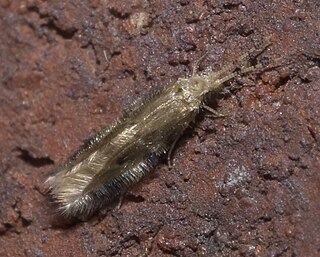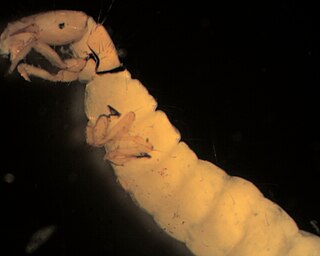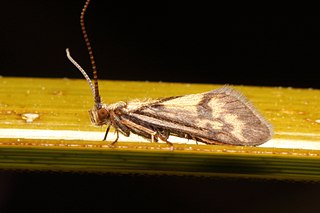
The caddisflies, or order Trichoptera, are a group of insects with aquatic larvae and terrestrial adults. There are approximately 14,500 described species, most of which can be divided into the suborders Integripalpia and Annulipalpia on the basis of the adult mouthparts. Integripalpian larvae construct a portable casing to protect themselves as they move around looking for food, while Annulipalpian larvae make themselves a fixed retreat in which they remain, waiting for food to come to them. The affinities of the small third suborder Spicipalpia are unclear, and molecular analysis suggests it may not be monophyletic. Also called sedge-flies or rail-flies, the adults are small moth-like insects with two pairs of hairy membranous wings. They are closely related to the Lepidoptera which have scales on their wings; the two orders together form the superorder Amphiesmenoptera.

The Annulipalpia, also known as the "fixed-retreat makers", are a suborder of Trichoptera, the caddisflies. The name of the suborder refers to the flexible terminal segment of the adult maxillary palps, which often has many tiny rings.

Sericostomatoidea is a superfamily in the order Trichoptera, the caddisflies.

The family Leptoceridae are a family of caddisflies often called "long-horned caddisflies". Leptoceridae is the second largest family of caddisflies with more than 1500 species in around 45 genera. The main identifying feature of most Leptoceridae is that their antennae are longer than those of other caddisflies. There is one genus with short antennae (Ceraclea), but it is easily identified by the pair of dark curved lines on the mesonotum.

Limnephilidae is a family of caddisflies with about 100 genera. They belong to the main lineage of case-constructing caddisflies, the Integripalpia or tube-case caddisflies. The Limnephilidae is one of the most species-rich Trichoptera families of northern temperate regions, but only a few are known from tropical areas and the Southern Hemisphere. For this reason they are often known as northern caddisflies.

Helicopsychidae are a family of Trichoptera. The name refers to the helix shaped larval cases and they should not be confused with Limnephilidae which sometimes inhabit the snail shells. Their shells range from 6–8 millimetres (0.24–0.31 in) and are crafted from mineral grains. Their typical habitat is in slow-flowing water in ditches. Helicopsychidae larvae have a comb-like anal hook. Helicopsychidae is divided into two extant genera, Rakiura and Helicopsyche, and two fossil genera Electrohelicopsyche and Palaeohelicopsyche. The family contains more than 270 species and are present on all major faunal regions.

The Hydroptilidae are a large family of caddisflies (Trichoptera) with a worldwide distribution. They are commonly known as microcaddisflies or purse-case caddisflies, in reference to two characteristic traits of this family: Hydroptilidae are much smaller than other caddisflies, rarely exceeding 5 mm (0.20 in) in length. Their larvae do not build a protective case until the final instar of their growth. At that time however, they build a typically Purse-shaped case, either portable or stuck to the substrate, in which the larva finishes growth and pupates.

The Hydropsychidae are a family-level taxon consisting of net-spinning caddisflies. Hydropsychids are common among much of the world's streams, and a few species occupy the shorelines of freshwater lakes. Larvae of the hydropsychids construct nets at the open ends of their dwellings which are responsible for their "net-spinning caddisfly" common name.

Philopotamidae is a family of insects in the order Trichoptera, the caddisflies. They are known commonly as the finger-net caddisflies.
Gary LaFontaine was a well-known fly fisherman and author. His books include Caddisflies, The Dry Fly: New Angles, Fly Fishing the Mountain Lakes, and Trout Flies: Proven Patterns. He died of Lou Gehrig's disease.
The nice part about fishing all the time is that an angler can spare moments for just sitting and watching the water. These spells don't even have to have a purpose, but it is hard not to discover some secrets during such interludes. The fisherman without a schedule doesn't need to rush about, casting furiously in a hunt for every possible trout. For this reason, he usually catches more of them.

The Fly-class river gunboats, collectively often referred to as the "Tigris gunboat flotilla", were a class of small well-armed Royal Navy vessels designed to patrol the Tigris river during the Mesopotamian Campaign during the First World War.

Limnephilus is a genus of caddisflies in the family Limnephilidae. There are over 180 species of Limnephilus, described between 1824 and 1999.

Limnephilini is a tribe of northern caddisflies in the family Limnephilidae. There are about 16 genera and at least 300 described species in Limnephilini.

Stenophylacini is a tribe of northern caddisflies in the family Limnephilidae. There are at least 20 genera and 190 described species in Stenophylacini.

Limnephilinae is a subfamily of northern caddisflies in the family Limnephilidae. There are at least 65 genera and 600 described species in Limnephilinae.

Chimarra is a genus of little black caddisflies in the family Philopotamidae. There are more than 630 described species in Chimarra.

Chilostigmini is a tribe of northern caddisflies in the family Limnephilidae. There are about 12 genera and at least 40 described species in Chilostigmini.

Wormaldia is a genus of fingernet caddisflies in the family Philopotamidae. There are more than 140 described species in Wormaldia. Fossil species have been described from the Late Cretaceous Burmese amber of Myanmar.

Chaetopterygini is a tribe of northern caddisflies in the family Limnephilidae. There are about 11 genera and at least 60 described species in Chaetopterygini.

Conoesucidae is a family of caddisflies in the order Trichoptera. There are about 12 genera and more than 40 described species in Conoesucidae.

















